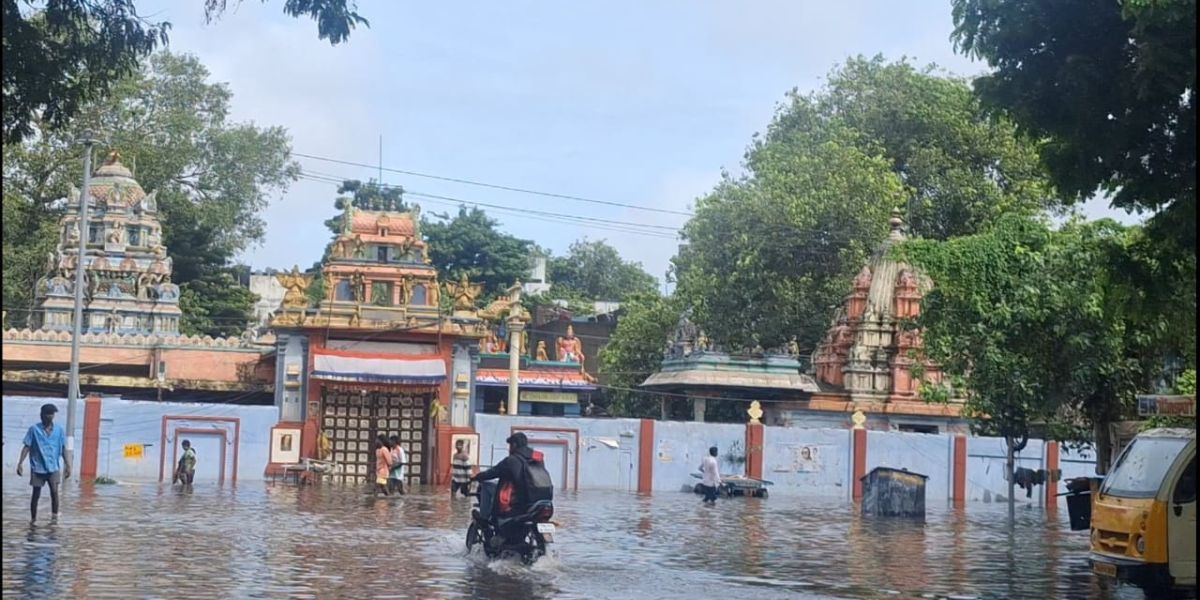According to a report from the Tamil Nadu State Disaster Management Authority, flooding has persistently affected North Chennai due to inadequate drainage systems. The report detailed the increasing frequency of flooding incidents in this region, worsened by climate change and urbanisation.
Published Oct 23, 2024 | 9:00 AM ⚊ Updated Oct 23, 2024 | 9:03 AM

A flooded street in North Chennai.
While South Chennai is predominantly occupied by privileged castes, North Chennai — Vada Chennai as known locally — is dominated by Dalit residents. With the northeast monsoon, that brings winter rain to the eastern coast now active, the days of dealing with flooding and slush are upon residents of this area.
“Since the age of eight, I’ve dreaded flooding. When it happens, sewage mixes with the water and flows into our homes, leaving a stench that lingers for days,” said Shalin Maria Lawrence, a Dalit writer and activist, speaking to South First about the “Climate Crisis” experienced in North Chennai.
“North Chennai, particularly areas like Vyasarpadi and Pattalam, stand as stark examples of urban neglect, where deep-seated caste dynamics and infrastructural deficiencies coalesce, leaving marginalised communities in dire straits,” Shalin Lawrence said.
A vocal advocate for residents of these neighbourhoods, she emphasises the emotional and physical toll that recurring flooding inflicts on families, already suffering marginalisation on account of their caste identity.
“The government’s indifference reflects an underlying belief that these communities do not deserve the same resources and attention as other parts of the city. This is not merely an oversight; it’s a systemic issue,” Shalin noted.
The emotional weight of these experiences is heavy for Shalin Lawrence, who recalled the impact of flooding from a young age. Each inundation brings not only the physical mess of sewage but also a psychological toll.
“The horror of having to wade through contaminated water, the smell that stays in our homes, it’s unbearable,” she said.
Other residents of this area find themselves similarly trapped in a cycle of despair every monsoon. The environmental challenges posed by climate change exacerbate these situations, turning a natural occurrence like rainfall into a public health crisis.
Ramasamy a resident of Pattalam told South First, “Despite voting for the DMK all these years, we feel ignored. Our roads are in terrible condition, and when floods hit, it’s always the same neighbourhoods that suffer. We need more than promises; we need action.”
Mahindara, a resident of North Chennai working as a florist in Egmore, said, “We live in fear of the floods. Our homes are flooded with sewage, and it’s a nightmare. We have always supported the DMK, but it feels like our cries for help are falling on deaf ears.”
He felt his whole community and neighbourhood had been ignored and left to struggle on their own.
Nityanand Jayaraman, an environmental activist, corroborates Lawrence’s assertions. He emphasised the dire need for improved infrastructure in North Chennai, to address sanitation and flooding.
“The government seems unwilling to invest in areas that are home to people from underprivileged castes, leaving them to fend for themselves,” he said.
Jayaram pointed out that despite numerous appeals for better drainage systems, waste management, and flood prevention measures, little has been done to alleviate the suffering of residents in these areas. “It’s as if the government has written off these areas, ignoring the pressing needs of people who reside here,” he said.
According to a report from the Tamil Nadu State Disaster Management Authority, flooding has persistently affected North Chennai due to inadequate drainage systems. The report detailed the increasing frequency of flooding incidents in this region, worsened by climate change and urbanisation.
According to the report, a government study highlighted that Vyasarpadi and Pattalam experienced incidents of flooding 50 percent above the city’s average over the last decade. Even so, these areas remain underfunded and overlooked in disaster management planning.
However, Thiru Vi Ka Nagar MLA P Sivakumar alias Thayagam Kavi, legislator for the regions including Pattalam and Choolaimedu, asserted that his jurisdiction has faced no major issues.
He emphasised that all necessary changes like monitoring repairs are promptly addressed, and actions are taken as early as the day after heavy rains and flooding. However, the legislator evaded questions regarding the prevention of flooding in the area asserting that it was not an issue there.
Another report notes that data indicated that a substantial portion of Chennai’s urban landscape has been transformed due to unplanned development, shrinking the natural capacity of water bodies to manage rainfall.
It was noted that half the major water bodies in the city have been encroached upon, severely limiting their ability to mitigate flooding. The residents of North Chennai, who have consistently voted for the DMK, feel neglected in the government’s disaster management and urban planning efforts.
Their grievances stem from the lack of attention and resources directed toward improving drainage and flood management in their neighbourhoods.
By July this year, the Greater Chennai Corporation (GCC) had announced plans to deal with the monsoon. It had identified 40 low-lying areas that are prone to flooding and announced a comprehensive plan involving the prompt use of motor pumps to drain water.
Rainfall has been falling in intense and brief spells as a consequence of climate change, complicating even disaster preparedness.
Dear #Chennaiites,
If you have any grievances to be addressed by the Greater Chennai Corporation, please contact us via the #GCC helpline at 1913.#ChennaiCorporation#HereToServe pic.twitter.com/nvwLSgKEax
— Greater Chennai Corporation (@chennaicorp) October 7, 2024
(Edited by Rosamma Thomas)
